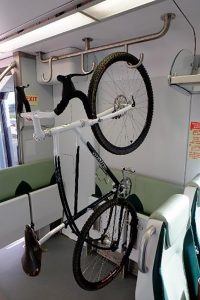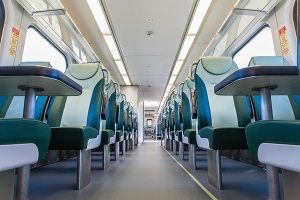
At the Penngrove Independence Day parade, residents filed into the Sonoma-Marin Area Rail Transit (SMART) diesel locomotive on display. They commented on its “new car smell” and lined up at the info desk on board, asking about bridge crossings while snagging railway logo backpacks.
“It’s great,” said Kathryn Harmon, a Santa Rosa resident, about the Bay Area’s newest transit system that will roll by year’s end. “It will save people’s commute.”
SMART officials expect weekday ridership on the green and grey trains to average 3,000 riders during the first year along the 43-mile, 10-station route between San Rafael and Santa Rosa. The transit system, which includes an accompanying bike and pedestrian pathway, will eventually cover a 70-mile stretch from Larkspur to Cloverdale. The additional mileage, along with five more stations, will be built out during a second construction phase that should start in southern Marin next year.
With 30 daily trips, SMART will provide an alternative to commuters who depend on Highway 101 to move between Marin and Sonoma counties. SMART is working with transit agencies to reconfigure bus routes, as needed, and provide connections to and from the first 10 stations.
“Our passenger trains will provide a safe, reliable, and efficient option to sitting in traffic gridlock on the 101,” said Farhad Mansourian, the agency’s general manager. “SMART passengers will be able to cut their travel times in half or more, with a stress-free, predictable commute.”
Similar to a Bay Area ferry experience, SMART plans to hire a vendor to sell morning coffee and pastries on board, and beer and wine in the afternoon. Trains also are WiFi-enabled.
SMART’s arrival will mark the first North Bay rail service to operate since the Northwestern Pacific Railroad closed nearly 60 years ago. Old track has been replaced and rebuilt with approximately 123,000 concrete railroad ties. Fifty-six crossings were rebuilt, and 49 bridges and trestles were built or repaired. SMART has a fleet of seven trains. Each two-car set can hold up to 300 seated and standing passengers, as well as two dozen bikes. Another four individual cars have been ordered.
The rollout comes amid greater emphasis on improving Bay Area commutes as transit providers seek to modernize existing services and meet growing demand. Within the realm of other railways, Caltrain officials recently approved $1.2 billion in contracts to electrify their system, while BART is preparing to serve new areas like Antioch and San Jose.
Rail expansion brings regional environmental benefits, too. SMART will prevent at least 30 million pounds of greenhouse gases from entering the atmosphere annually by removing 5,300 car trips daily from North Bay roads, according to an environmental impact report. Additional reductions are expected from thousands of trips on the accompanying bike and pedestrian pathway.
The first phase of SMART construction began in 2012, costing $450 million and funded by Measure Q, the one-quarter-cent sales tax passed by Sonoma and Marin county voters in 2008. For the second phase of construction, $250 million in funding is needed to build extensions north to Windsor, Healdsburg, and Cloverdale, according to estimates provided by SMART’s Communication and Marketing Director Jeanne Mariani-Belding.
Construction on the $42 million Larkspur Station will begin next year — funded, in part, by federal grant money and $20 million from the Metropolitan Transportation Commission — with plans to open in 2018.
For all of SMART’s potential to whisk commuters to work and tourists to wine country, concerns remain about whether commuting habits will adapt enough to achieve full ridership — and deliver returns on the multi-million dollar transit investment. Some of the naysaying has dogged SMART from the start. Opponents sought a repeal election four years ago on the sales tax subsidizing the train, but the effort was unsuccessful. Some residents still air frustrations on social media, mainly questioning whether fares are competitively priced.
Mariani-Belding said she and other rail officials are “literally speaking to hundreds of people at outreach events,” including at booths at the Marin County Fair in July. Feedback is positive once residents grasp how fares work, she said.
Along the system’s five fare zones, commuters will pay a base $3.50 fare for the first zone traveled, plus $2 per zone thereafter. So, for example, a trip originating at the Novato-San Marin Station heading to downtown San Rafael spans two zones for a $5.50 fare. Travel across five zones is $11.50, although most riders will make two- to three-zone trips on average, Mariani-Belding said.
Discounts slice fares in half for youth, seniors, veterans, college students, and disabled riders. Commuters who catch annual “eco-passes” through employers can save up to 50 percent, depending on the number of company passes purchased. Riders taking Clipper Card-enabled transit systems to connect to SMART trains will get transfer credits up to $1.50.
The higher the ridership, the greater potential there is for benefits such as sustainable fare revenue, productivity gains, and traffic reduction, said Dr. Robert Eyler, professor of economics and dean of the School of Extended and International Education at Sonoma State University.
“We’re all playing a waiting game to see what ridership and adoption will be,” he said.
Most commuters won’t consider their rail commute logistics until the trains are up and running, so first impressions around stations will matter. Santa Rosa CityBus is among several North Bay transit agencies that have made presentations to SMART about how to link schedules, as well as improve rides to key hubs like downtown where four bus routes circulate.
“We carry about 8,800 people a day,” said Rachel Ede, a Santa Rosa transit planner. “It’s a process to see how many want to make those connections, and if there are certain train connections we should be prioritizing. We’re feeling that out.”
Golden Gate Transit’s Priya Clemens reported that her agency is working with SMART to create an efficient system for transfers in San Rafael.
“We’re also considering implementing a shuttle service which would bring riders from the train to the Larkspur Ferry Terminal,” Clemens said.
SMART is aligning with various chambers of commerce and local employers for additional shuttles. The Santa Rosa chamber, for example, has “identified interest” from employers like Sutter Health, Kaiser, and Medtronic, and met in late July to discuss a route and preliminary cost estimates, said Jonathan Coe, president and CEO.
In the meantime, SMART’s staff is conducting “aggressive” system-wide testing — inclusive of rail conditioning, crossing gates, and control systems — to ensure the smooth running of the fleet.
“If the rail is not conditioned properly, the timing may be off,” Mariani-Belding said. “If we’re off by a minute on our schedule, we need to know and adjust that.”
Safety awareness is a big priority, too, conditioning residents to living in an area with a fully operational rail service.
“This is a project discussed and debated for decades,” Mariani-Belding said. “We’re in the home stretch of making it a reality.”
Cecily O’Connor covers transportation for the Monitor.

